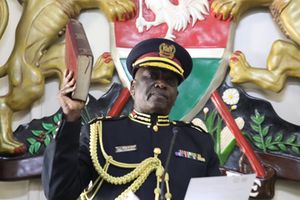In the Mara, humans and wild animals clash in a deadly struggle for survival

This dam in the Mara North Conservancy used to hold water for six months. Now it dries up in three months or less
What you need to know:
- As water sources dry up and pastures wither, wildlife ventures closer to human settlements in search of food and water.
- This movement often brings them into direct conflict with local communities, leading to crop destruction, livestock predation, and sometimes, loss of human life.
The Maasai Mara, one of Kenya's most treasured natural landscapes and a tourist attraction has long been defined by the seasonal migration of wildlife, the rhythms of rainfall, and the deep-rooted traditions of the Maasai people.
However, in recent decades, the delicate balance between humans and nature in this iconic ecosystem has been severely disrupted by the growing impacts of climate change. This shift has intensified human-wildlife conflicts, where communities and wildlife increasingly find themselves in a struggle for survival.
"All my life I have lived with wildlife," says Daniel Sopia, the chief executive officer of the Maasai Mara Wildlife Conservancies Association. " I grew up studying them, and I know they are dangerous animals. I can take you to where the lions and elephants are.
It's a tourist destination for others, but for me, it’s home. That’s why I’ve spent my adult life protecting this wildlife." Climate change, manifesting in prolonged droughts, unpredictable rainfall and extreme weather events, is altering the very fabric of the Maasai Mara ecosystem.
As water sources dry up and pastures wither, wildlife ventures closer to human settlements in search of food and water. This movement often brings them into direct conflict with local communities, leading to crop destruction, livestock predation, and sometimes, loss of human life.
"I have lived in the Maasai Mara outskirts all my life. I was born here. I have seen how climate change has changed this ecosystem, but I have also seen how humans have damaged the environment further," offers James Mbusia. He is a livestock herder and community leader who spends his days talking to his neighbours about why they should not encroach on wildlife corridors.
Jeffrey Liaram, Senior Sergeant at Pardamat conservation area and his team spend their days patrolling the vast areas of the conservancy to ensure both humans and wildlife are protected from each other. "You see this?" Liaram asks as he bends to pick up pieces of wool from the ground.
"These are the remains of a sheep. There are no bones, no blood, just wool. That is all that is left. You can see hyena droppings over there, so it was likely eaten by hyenas." Human-wildlife conflict in the Maasai Mara has reached alarming levels in recent years, largely driven by the competition for dwindling resources exacerbated by climate change.
Elephants, in particular, have become a symbol of this conflict. As their natural habitats dry up, they raid farmlands in search of food and water, leading to devastating losses for local farmers. One elephant raid can destroy a season's crops, leaving families without food or income.
"Elephants are the worst! I am not afraid of lions, I am afraid of elephants," Daina Molela, a ranger at Pardamat, said. She recently joined the team as one of the few women rangers in the conservancies. She shares a story of how she once found herself surrounded by an elephant herd during patrol. “I was so scared, I ran away. I’d rather run toward a lion than an elephant—they are very destructive.”
Historically, the Mara has relied on the biannual rains to sustain its lush grasslands and water bodies. The long rains between March and May and the short rains in November were vital for replenishing pastures that fed livestock and wildlife. In recent years, however, these rains have become unreliable.
Prolonged droughts have become more frequent, leading to the drying up of rivers and the shrinking of waterholes. The famous Mara River, a lifeline for the ecosystem and the famed crossing point for migrating wildebeest, now has significantly reduced flow levels, threatening the survival of both wildlife and livestock.
"This water pan is a key water source for both wildlife and domestic animals in this conservancy, " says Raphael Kereto, a grazing manager at the Mara North Conservancy. "We use it as a key indicator of climate change because we have noticed that while previously the pan would hold water for at least six months, it is now drying up much faster, in three months or less."
In response to these challenges, the conservancy model has emerged as a promising solution to the intertwined issues of climate change, human-wildlife conflict, and biodiversity conservation in the Maasai Mara.
Conservancies are community-managed areas that prioritise both conservation and the sustainable use of natural resources. They are established through agreements between local landowners, typically Maasai pastoralists, and conservation organisations or tourism operators.
"The model is based on trust and mutual benefit between us and the community. They lease the land to us, we open up the wildlife corridors that were previously blocked, restore the ecosystem and then pay them a monthly income," Sopia offers.
"Today there are about 24 conservancies in the Mara ecosystem, managing more land than the national reserve itself. By 2030, five more conservancies will be opening up," he adds.
According to Kereto, the conservancy has 850 landowners who have leased land to them. "They don't have equal shareholding. Some have given us 100 acres, others 1,000. So the lease is renewed every couple of years, but one key thing we do is to encourage the communities to move away from wildlife corridors and pull down any fences they have built to allow the free movement of the animals," Raphael says.
The conservancy model operates on the principle that conservation and community well-being are not mutually exclusive but can be mutually reinforcing. By creating incentives for local communities to participate in and benefit from conservation, conservancies help reduce conflict drivers and build resilience against climate change impacts.
In the grazing system, each landowner is responsible for his herd and cannot deviate from the grazing plan. By only grazing the livestock in one block at a time, the herders are assured of feed all year round.
"We divide the land into grazing blocks and then move from block to block every few months. We have an active block at the moment with 20,000 livestock and when they move, the dung they leave behind becomes manure, paving the way for fresh grass to germinate," offers the grazing manager.
In the Maasai Mara, conservancies typically operate on a leasehold system. Landowners, who are often Maasai pastoralists, lease their land to the conservancy in exchange for a guaranteed income. This income is usually derived from tourism revenues generated by the conservancy.
By pooling their land together, they create large, continuous areas that are managed for conservation and sustainable tourism, rather than being subdivided for agriculture or settlement.
"As a tourist camp inside a conservancy, our business model is not profit-driven. We exist to support the conservation efforts and generate some income for the community hosting us," says Wilson Odhiambo, general manager at Mahali Mzuri Safari Camp in the Olare Motorogi Conservancy. “We also give back to the community by hiring local staff and participating in habitat rehabilitation."
The success of the conservancy model in the Maasai Mara ecosystem has ignited a glimmer of hope for pastoral communities, offering a sustainable solution in the face of future droughts. There are also plans to expand the model and open up more land in the coming years, paving the way for long-term growth and development.



